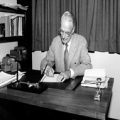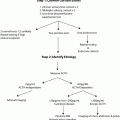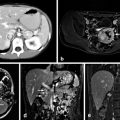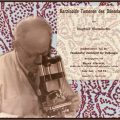Aidan Carney. (Courtesy of Mayo Clinic)
Prior to genetic testing, the understanding of genetic endocrinopathies required the commitment and interest of astute clinicians treating patients with an interest in associating rare diseases. Conditions may have been described in only a single patient with a rare combination of diseases that required persistent and ongoing interest. Few have made contributions as important as J. Aidan Carney , M.D., Ph.D., in the field of endocrine surgery.
Dr. Carney’s career at Mayo Clinic has spanned over five decades and continues today authoring more than 200 original articles including more than 90 articles after retirement. However, his interest in pathology and medicine began across the pond. Dr. Carney was born in Roscommon, Ireland on January 21, 1934. He was the son of Frances Howley Carney and Richard Gerard Carney. He attended Glongowes Wood College in Naas, Co. Kildare near Dublin from 1947 to 1952 and obtained his M.B.B. Ch in 1959 from the University College of Dublin. From 1959 to 1960, he was an intern in St. Vincent’s Hospital in Dublin, Ireland, and subsequently worked in the pathology department at both the University College and Richmond Hospital up to July 1962. He received his Ph.D. from the University of Minnesota in 1969, while working at Mayo Clinic, with his dissertation entitled “Morphology of Myosin and Thick Myofilament Diameter in Experimental Cardiac Hypertrophy.” This special interest in the pathology of cardiac muscle was maintained throughout his career. At the time, he may not have realized that this interest would serve him well in understanding the complex pathologic relationship that would later bear his name.
He began his career at Mayo Clinic , Rochester, as a resident in the Department of Pathology from 1962 to 1966 and received an appointment as an assistant to the staff and associate consultant in 1966. Dr. Carney was married to Dr. Francoise Le Guen of Port Louis, Mauritius, on June 16, 1962. She was an accomplished anesthesiologist in her own right, appointed as a fellow in the Department of Anesthesiology in the Mayo Graduate School of Medicine from 1962 to 1965 as well as a member of the faculty of the Department of Anesthesiology in Mayo Clinic from October 1, 1965.
Dr. Carney’s interest in endocrine disorders and syndromes began in 1966 after reading a paper by Dr. Dillwyn Williams which described the syndrome of multiple endocrine neoplasia 2B (MEN 2B). Dr. Carney’s initial contribution included descriptions of medullary hyperplasia in bilateral pheochromocytomas in MEN 2B. Later, investigations led to reporting previously unrecognized syndromes—most notably Carney triad , Carney complex , and Carney Stratakis syndrome . Identification of these entities was accomplished through years of collecting unusual cases, establishing rapport with patients, exhaustive detective work with follow-up from around the world, and synthesis of seemingly unrelated findings into coherent clinical and pathological entities.
In understanding subtle connections between rare disease processes, Carney established several rules which he continues to abide by: (1) the concurrence of the tumors is statistically unlikely even in one patient because of their rarity; (2) the neoplasms are often multiple in the affected organs; (3) the lesions appear at an age when tumors are not expected especially when compared to their sporadic counterpart; and (4) the association has a pronounced sex predilection—“then a case can be made for concluding that the concurrence of the tumors is likely not coincidental.”
Based on the presence of these principles, the association involving gastric intestinal stromal tumors (GIST), pulmonary chondromas, and functional extra-adrenal paragangliomas became clearly evident. This constellation was one of Dr. Carney’s first descriptions of syndromic associations and was described in the New England Journal of Medicine in 1977. This became to be known as Carney’s triad [1].
His interest in this triad began after reviewing an article by Henry D. Appleman, M.D., from the University of Michigan in Ann Arbor. In line with his principles of understanding syndromic associations, he noted that out of 127 cases of GIST tumors, three occurred predominantly in women of young age, were multiple, and had an insidious development with slow-growing well-localized tumors compared to the other 124 cases which are most often presented in men in their fifth or sixth decade with malignant aggressive tumors.
In his initial report, he described the concurrent appearance of three unusual tumors in four young patients: pulmonary chondroma, epithelioid leiomyosarcomas, and functioning paragangliomas. In subsequent reports by himself and others who had developed an interest in the association, the tumors of this triad occur at various times, often with long periods of time between their appearances in a given patient.
Stay updated, free articles. Join our Telegram channel

Full access? Get Clinical Tree







